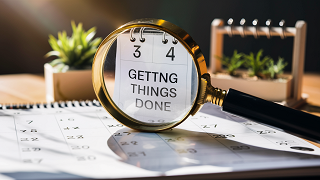
Getting Things Done
In today’s fast-paced world, our to-do lists often resemble monstrous behemoths, constantly threatening to overwhelm us. We juggle work deadlines, personal errands, social commitments and self-improvement goals, all vying for our limited time and attention. This constant pressure breeds stress, anxiety and a nagging feeling of being left behind.
Enter David Allen’s Getting Things Done (GTD), a revolutionary productivity framework lauded for its ability to transform chaotic to-do lists into streamlined systems. GTD doesn’t just help you manage tasks; it empowers you to capture everything swirling around in your mind, freeing your mental space for focused work and creative thinking.

The Core Principles of Getting Things Done (GTD)
GTD operates on five core principles:
- Capture: Gather all your commitments, tasks and even fleeting ideas from every possible source – your mind, sticky notes, emails, conversations. Don’t let anything slip through the cracks.
- Clarify: Process the captured items. Decide what each item truly is: a project, a next action or something to refer to someday. Projects require multiple steps to be completed, while next actions are the singular, physical steps you need to take to move a project forward. Reference materials are resources you might need in the future but don’t require immediate action.
- Organize: Place clarified items in appropriate lists based on their category (projects, next actions, waiting for, etc.). This ensures everything has a designated location within your system.
- Reflect: Regularly review your system – your projects list, next actions list and calendar – to maintain clarity and identify priorities. This helps you stay on top of your commitments and adjust your course as needed.
- Engage: With a clear understanding of your tasks and priorities, you can finally engage in focused work on the most important next actions. The mental clutter is removed, allowing you to enter a state of flow and achieve more with less effort.

Benefits of GTD
Implementing GTD can dramatically improve your life in several ways:
- Reduced Stress and Anxiety: By capturing everything from your mind and organizing it efficiently, you eliminate the fear of forgetting something important. This reduces mental clutter and anxiety, leading to a calmer and more focused state of mind.
- Increased Productivity: Knowing exactly what needs to be done and having a clear system to follow allows you to prioritize tasks effectively and work with laser focus. You’ll waste less time wondering what to do next and spend more time actually doing it.
- Improved Time Management: GTD encourages scheduling specific times for focused work sessions, allowing you to optimize your calendar and maximize your time.
- Enhanced Creativity: By freeing your mind from the burden of remembering and managing tasks, you create space for creative thinking and problem-solving.
- Sense of Accomplishment: The act of completing tasks and checking them off your list provides a satisfying sense of accomplishment, boosting motivation and keeping you engaged in the process.

Putting GTD into Practice: Practical Steps
Getting started with GTD may seem daunting, but by following these steps, you can build your own successful system:
- Gather Your Tools: Choose tools that work for you – a physical notebook, a digital app or a combination of both. GTD doesn’t prescribe a specific method, so find what best suits your preferences.
- Capture Everything! Start by capturing every open loop, task or idea that’s floating around in your head. Don’t worry about categorization at this stage; just get it all out on paper (or digitally).
- Process Your Capture List: Go through each item on your capture list and decide what it is. Ask yourself: “Is this actionable? Is it a project requiring multiple steps? Or is it something I just need to reference in the future?”
- Organize Your Lists: Create lists for projects, next actions (categorized by context, like “calls to make” or “errands to run”), waiting for (things out of your control) and someday/maybe items.
- Schedule Regular Reviews: Set aside time each week or month to review your lists. Update your project lists, identify priority next actions and ensure everything is in its proper place.
- Start Engaging! With a clear understanding of your priorities and next actions, finally engage in focused work. Don’t jump to the next task until you complete the one you’re currently on.

Conclusion
Getting Things Done is not a rigid system; it’s a flexible framework that can be adapted to your unique needs and preferences. Experiment with different tools and approaches to find what works best for you. Consistency is key. Regularly reviewing your lists and taking action on your next actions is crucial for maintaining a streamlined system and experiencing the full benefits of GTD.
By embracing GTD and its core principles, you can finally tame the to-do list monster, reclaim control of your time and attention and achieve a state of stress-free productivity. Remember, the goal isn’t to have an empty to-do list; it’s to have a clear understanding of your priorities and the confidence to tackle them with focus and purpose.
Additional Resources
Website
The Official GTD Website: https://gettingthingsdone.com/what-is-gtd – Articles, courses and certified Getting Things Done coaches to guide you through the implementation process.
Books
Getting Things Done: The Art of Stress-Free Productivity by David Allen: The definitive guide to Getting Things Done, written by its creator David Allen. This book provides a comprehensive explanation of the entire system, along with practical exercises and real-life examples.
Getting Things Done Workbook: 10 Moves to Stress-Free Productivity by David Allen: A companion to the main Getting Things Done book, this workbook offers interactive exercises and prompts designed to help you personalize and implement GTD in your own life.
The Checklist Manifesto: How to Get Things Right by Atul Gawande: While not directly related to Getting Things Done, this book explores the power of checklists in reducing errors and improving efficiency. The principles discussed can be incorporated into your GTD system for added organization and reliability.
Eat That Frog! by Brian Tracy: This book complements Getting Things Done by focusing on overcoming procrastination. Tracy emphasizes the importance of tackling your most challenging task (the “frog”) first thing in the day. Aligning this concept with Getting Things Done helps you prioritize your next actions effectively.
Deep Work by Cal Newport: In today’s digital world, distractions are abundant. Newport’s Deep Work emphasizes the importance of focused, uninterrupted work sessions for accomplishing complex cognitive tasks. Getting Things Done, by removing mental clutter and prioritizing tasks, creates an environment conducive to deep work.














